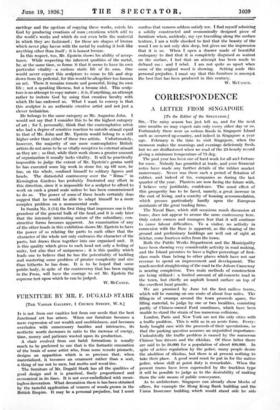ART
THE SCULPTURE OF MR. EPSTEIN
ON press day I found myself alone in the Leicester Galleries with the new works of Mr. Jacob Epstein. This experience left upon my mind an impression more powerful than I had previously had at any other exhibition of either painting or sculpture, which it would be quite impossible to communicate to• those of my readers who have not had an opportunity of viewing these works under similarly favourable conditions.
It was an experience which was almost uncanny, like that of entering, for the first time, some alien temple of worship, where so much striving had gone towards the intangible that, as a compensatory relief and as a concession to man's earthly desires, some more tangible expression in the form of symbolic idols had to be found.
These works of Mr. Epstein are quite frankly in the nature of idols. They are not attempts to depict the human form as it is or as the artist would like it to be. They are no mere expression of a sensuality which, out of some false sense of sexual shame, must transform the object of desire into some material less fleshly, some form more safe from covetousness. They are not the work of the imitator who imitates to flatter and flatters in order to possess, nor are they the work of the self-flatterer who, because of a misdirected sense of sin de- sexualizes the human form that he may pride himself on his idealization of it. They are the works of one who can innocently and humbly accept the works of God without shame or censorship—one who, realizing the futility, the sacrilege and the egotism of copying these works, extols his God by producing creations of man ; creations which add to the world's works and which do not even belie the material in which they are fashioned ; for these are shapes of bronze which never play havoc with the metal by making it look like anything other than itself ; it is honest bronze.
In this respect, too, Mr. Epstein shows his ability of accep- tance. While respecting the inherent qualities of the metal, he, at the same time, so forms it that it seems to have its own particular vitality—a curious static life of its own. One would never expect this sculpture to come to life and step down from its pedestal, for this would be altogether too human an act. There it remains remote and powerful, living its own life ; not a speaking likeness, but a bronze idol. This sculp- ture is no attempt to copy nature ; it is, if anything, an attempt rather to imitate God by using that creative faculty with which He has endowed us. What I want to convey is that this sculptor is an authentic creative artist and not just a clever technician.
He belongs to the same category as Mr. Augustus John. I would not say that I consider this to be the highest category of art ; for I, personally, think that the contemplative artist who had a degree of sensitive reaction to outside stimuli equal to that of Mr. John and Mr. Epstein would belong to a still higher order than either of these two artists. Unfortunately, however, the majority of our more contemplative British artists do not seem to be so vitally receptive to external stimuli as they are ; so that, while their work shows a greater amount of organization it usually lacks vitality. It will be practically impossible to judge the extent of Mr. Epstein's genius until he has executed some big work in stone for, up till now, he has, on the whole, confined himself to solitary figures and heads. The distasteful controversy over the " Rima " in Kensington Gardens has probably frustrated any effort in this direction, since it is impossible for a sculptor to afford to work on such a grand scale unless he has been commissioned to do so. The power of some of these heads certainly does suggest that he would be able to adapt himself to a more complex problem on a monumental scale.
In Sunita No. 3 (14) the first thing that impresses one is the grandeur of the general bulk of the head, and it is only later that the intensely interesting nature of the subsidiary, con- structive forms becomes apparent. An examination of any of the other heads in this exhibition shows Mr. Epstein to have the power of so relating the parts to each other that the character of the whole not only embraces the character of the parts, but draws them together into one organized unit. It is this quality which gives to each head not only a feeling of unity, but also that of uniqueness ; it is this quality which leads one to believe that he has the potentiality of tackling and mastering some problem of greater complexity and size than hitherto he has done. It is to be hoped that some public body, in spite of the controversy that has been raging ih the Press, will have the courage to set Mr. Epstein the supreme test upon which he can be judged.
W. MCCANCE.











































 Previous page
Previous page